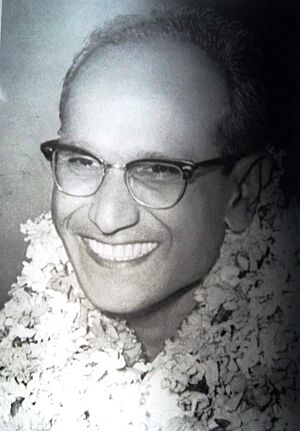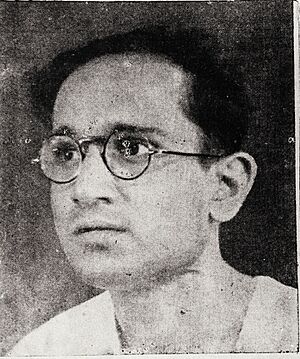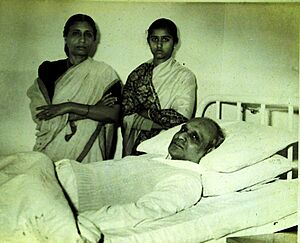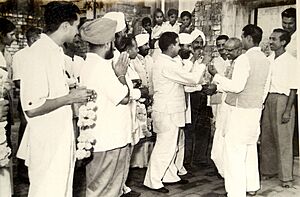Batukeshwar Dutt facts for kids
Quick facts for kids
Batukeshwar Dutta
|
|
|---|---|

Dutta in 1952
|
|
| Born | 18 November 1910 |
| Died | 20 July 1965 (aged 54) |
| Nationality | British Indian (1910–1947) Indian (1947–1965) |
| Occupation | Freedom Fighter |
| Organization | Hindustan Socialist Republican Association Naujawan Bharat Sabha Communist Consolidation |
| Known for | Indian Freedom Movement |
| Criminal penalty | Life imprisonment |
Batukeshwar Dutt (sometimes spelled Dutta; 18 November 1910 – 20 July 1965) was an important Indian freedom fighter. He believed in a fair society where everyone had equal chances. He is most famous for an event on 8 April 1929. On that day, he and his friend Bhagat Singh threw two bombs inside the Central Legislative Assembly in New Delhi.
They were arrested, tried, and sent to prison for life. While in prison, they started a very important hunger strike. They protested against the unfair way Indian political prisoners were treated. Their actions helped secure better rights for these prisoners. Batukeshwar Dutt was also a member of the Hindustan Socialist Republican Association. This was a group that worked for India's freedom.
Contents
Early Life and Freedom Fight
Batukeshwar Dutt was also known as B. K. Dutta or Battu. He was born on 18 November 1910. His birthplace was Khandaghosh village in West Bengal. He came from a Bengali family.
He finished school at Pandit Prithi Nath High School in Kanpur. There, he met other freedom fighters. One of his closest friends was Bhagat Singh, whom he met in 1924. Dutt learned how to make bombs while working with the Hindustan Socialist Republican Association (HSRA).
The 1929 Assembly Bomb Incident
The British government wanted to stop revolutionaries like Bhagat Singh. So, they planned to use a strict law. This law was called the Defence of India Act 1915. It would give the police a lot of power.
Bhagat Singh had an idea from a French anarchist. He suggested throwing a bomb inside the Central Legislative Assembly. The HSRA agreed to this plan. The goal was not to hurt anyone. It was to make a loud statement against the new laws.
At first, Dutt and Sukhdev Thapar were chosen for the task. But later, the plan changed. Dutt was chosen to go with Singh. On 8 April 1929, Singh and Dutt threw two bombs. They threw them from the Visitor's Gallery. Smoke filled the hall. They shouted "Inquilab Zindabad!" which means "Long Live the Revolution!". They also threw leaflets. These leaflets explained that their act was against unfair new laws. They also protested the death of Lala Lajpat Rai. No one died in the explosion. Only a few people had minor injuries. Singh and Dutt said they did not mean to cause harm. They were arrested, just as they had planned.
The Trial and Hunger Strike
Batukeshwar Dutt, along with Bhagat Singh and Sukhdev Thapar, faced a trial. This was known as the Central Assembly Bomb Case. In 1929, a judge in Delhi sentenced Dutt to life imprisonment. He was sent to the Cellular Jail. This jail was on the Andaman and Nicobar Islands.
During their trial, Dutt and Singh showed great bravery. They did not accept the court's authority. Instead, they used the trial to share their ideas. They wanted India to be free. After being sentenced, they started a famous hunger strike. They protested the poor treatment of Indian political prisoners.
The hunger strike lasted for 63 days. Prison officials treated them very harshly. But Dutt and Singh did not give up. They continued their strike. Eventually, some of their demands were met. This helped improve conditions for other prisoners.
Later Life and Legacy
After being released from prison, Dutt became very sick. He had tuberculosis. Even so, he joined the Quit India Movement. This was a big movement led by Mahatma Gandhi. Dutt was jailed again for four years. He was held in Motihari Jail in Bihar.
After India became independent in 1947, he married Anjali. Sadly, independent India did not give him much recognition. He lived a difficult life, often struggling financially. He even had to start a transport business to earn money.
Batukeshwar Dutt lived longer than most of his friends from the freedom struggle. He passed away on 20 July 1965. He died in a hospital in Delhi after a long illness. He was cremated in Hussainiwala, Punjab. This is the same place where his friends Bhagat Singh, Shivaram Rajguru, and Sukhdev Thapar were cremated. He is survived by his daughter, Bharti Dutta Bagchi. Dutt also helped write the film Shaheed (1965).
Recognition
A colony in New Delhi is named after Batukeshwar Dutt. It is called B. K. Dutt Colony. It is located near Safdarjung Airport.
Anil Verma wrote a book about him. The book is titled Batukeshwar Dutt: Bhagat Singh ke Sahyogi. It was released on Dutt's 100th birthday. The Government of India published this book. It was the first book ever written about Dutt in any language.
See also
- Ashfaqulla Khan
- Kakori Train Robbery




